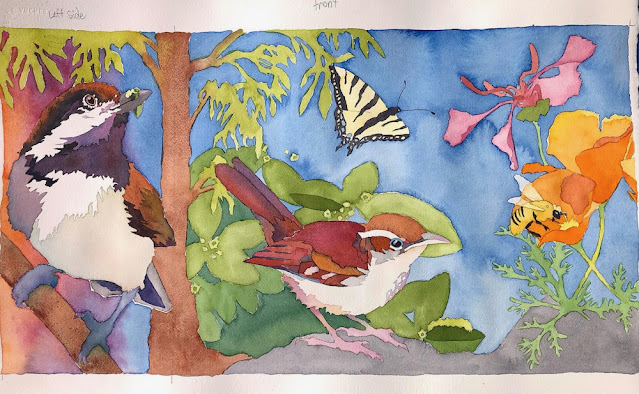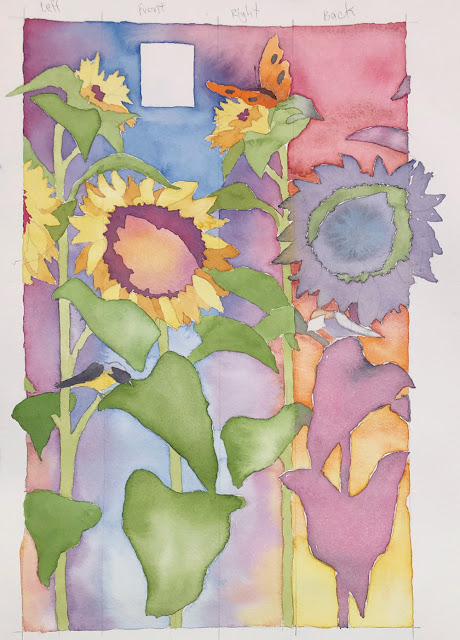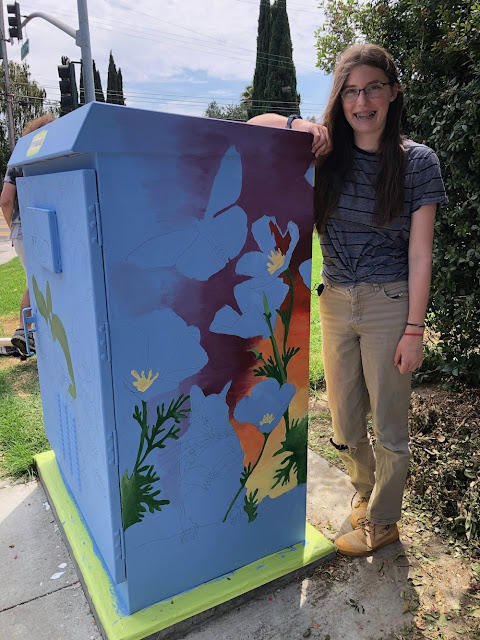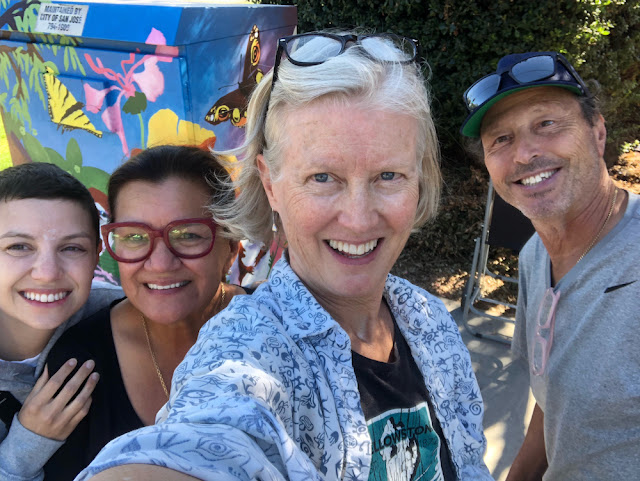If you live in a city, you've seen those big metal cabinets near many intersections. Some are cable cabinets, but others are signal control cabinets. In many cities, permission is given to artists to brighten up these boxes with art.
I've always wanted to paint one of these boxes, and a few months ago a friend sent me our neighborhood association's Call for Artists. I emailed the group enthusiastically, including the link to my art website and Instagram page. They accepted me! Thus began a weeks-long project that was gratifying and challenging.
 |
| My utility boxes before |
Developing a Plan
First, I had to design and submit a color sketch to be approved by the neighborhood association and the Art Box coordinator for the city. I visited my box, actually two boxes, and took measurements.
 |
Scale pencil sketches on paper
|
I did several pencil sketches of what I wanted on the box. I've done many paintings of birds, insects, and plants, so I chose a few favorites to include. After several sketches, I realized I wanted the birds and other animals to be larger than life for a bigger impact when driving by.
As member of the local native plant society, I knew I wanted to showcase some of the animals and plants native to our area. The Willow Glen Neighborhood Association, who funded this project, required me to include a willow tree, so I included an Arroyo Willow (Salix lasiolepis). Other plants included California Coffeeberry (Frangula californica), California Poppy (Eschscholzia californica), and Elegant Clarkia (Clarkia unguiculata). Animals I chose are Chestnut-backed Chickadee (Poecile rufescens), Bewick's Wren (Thryomanes bewickii), Western Tiger Swallowtail (Papilio rutulus), California Bumblebee (Bombus Californicus), Lesser Goldfinch (Spinus psaltria), and Gulf Fritillary (Dione vanillae). Included a sunflower (Helianthus annuus) because they're native to the Americas and the birds and bees love them, too!
And as a climate activist, I was also looking for a way to further awareness of the climate crisis (look here to find out about the climate action team I'm part of). So the front of each box has a beautiful blue sky and healthy organisms, while the back is a fiery apocalypse with ghost birds and insects and scorched plants. The idea for ghost birds came from the short story The Ghost Birds by Karen Russell.
Next, I painted those sketches in watercolor, and submitted the color plans for approval.
 |
| Color plan in watercolor for left side and front of box: plants and animals native to San Jose |
 |
| Color plan for the right side and back of box: fiery apocalypse with ghost plants and animals |
 |
| Color plan for tall box: sunflower and goldfinch wrap around to fiery ghost sunflower |
I heard back from Cherri promptly: my plan was approved!
 |
| Transferring the drawings onto large butcher paper |
Next, I had to enlarge my drawings to the size of the boxes. I don't have a projector, so I used a combination of a grid and enlarging key parts 400% on our printer. Luckily, we have very large windows, so I was able to tape and trace, using the window as a light box. Next time, I'm going to borrow or buy a projector! (about 18 hours of work so far)
Now I could go ahead and buy the materials. I bought 2 quarts of exterior primer at Home Depot in blue and yellow, along with brushes, sandpaper, and cleaning supplies. I bought tubes of acrylic paint at Michael's and more brushes. Also graphite transfer paper. (2 hours)
Preparing to Paint
The least fun part was cleaning and prepping the boxes. I had to scrape off old paint and bird poop, sand them and wash them. Whew!
The next day, I put masking tape over parts that were not to be painted, then gave each box two coats of primer. (4 more hours)
 |
| Sanding |
 |
| Primer |
 |
| Front primed! |
 |
Back, too
|
Drawing and Painting the Boxes
Finally, it was time to get the images on those boxes. On the first day, several people had offered to help, so I accepted. My neighbor Kannan was a great help in setting up the canopy for shade. As I began to transfer the drawings onto the boxes, I realized I had miscalculated, so had to squeeze in the bird, butterfly and flowers on the front and back sides. I taped the graphite paper under the drawing, then traced. This took about 4 hours.
Meanwhile, my two other painters arrived, and I set them up to start painting. Kannan helped me transfer some drawings, too.
We made a good start! I was pretty worn out, but I was grateful for their enthusiasm and support.
 |
| Karina and Kannan transferring the drawings |
 |
| Anika's lovely background painting |
 |
| Karina's beautiful background |
 |
| I painted the fiery background on the back |
After that, I decided to work at a more relaxed pace. I realized that I do my best work in solitude and quiet. Also in cool and shade. By 10am, the sun would bake the sidewalk there, and even with the canopy it was pretty hot. Thus began my almost daily routine: I painted from 7am to 10am, went home to clean up, eat breakfast, and do my other tasks. I returned to the boxes at 4pm until 7pm. That gave me 6 hours of painting on most days.
 |
| Chipmunk taking shape |
 |
| Began the big chickadee |
 |
| Willow tree, coffeeberry, and western swallowtail butterfly on the front |
 |
| Drawing and painting this grill was challenging |
 |
| Hello, bee! |
 |
| California poppies and clarkia flower taking shape |
 |
| Common Buckeye butterfly and chipmunk with poppies |
 |
| I finished the feet! |
 |
| And there's the Bewick's Wren hunting for caterpillars! |
 |
| Ghostly plants taking shape |
 |
| Painting in the afternoon |
 |
| Ghost bird and sunflower |
 |
Painting and listening to audiobooks. This was the trickiest surface to draw and paint! |
Visitors
Most of my hours at the art box were quiet, with the hum of nearby traffic and the twitter of birds. I was entertained by the variety of music emanating from people's vehicles, and annoyed by the loud vroom of some. I was encouraged by the many folks who yelled supporting messages from their cars or bikes, "Thanks for doing that!" or "Looking great!" Every evening around 6:00 the lesser goldfinches would serenade me with their chorus of "tweee-tweee!"
There were many pedestrians of course, and dogs out for walks. Cowboy and Holmes were regular visitors.
I usually paint in watercolors, so using acrylic paint was a challenge at first. But through so many hours of work, I learned a great deal. I got better at estimating how much of a certain color to mix for an area. I honed my skills at blending colors on the painting, and which brushes gave me the desired effects. Acrylic is more forgiving than watercolor paint, so I could lighten the willow leaves easily by painting over them.
I'm so pleased with how this Art Box turned out. It was a lot of work, but I'd do it again!
I must give a heartfelt thank you to the Willow Glen Neighborhood Association for sponsoring my Art Box, and for Cherri at Phantom Galleries for her support. I also thank my husband Hugh for his patience with my long days at that street corner. And of course to all the people and canines who expressed their support as they walked, rode, and drove by!
 |
| All finished: took off the masking tape, signed it, and cleaned up! |
 |
| The front side |
 |
The back side
|
 |
| Ghost goldfinch |
 |
| See ya later, art box! |






































Comments
Post a Comment